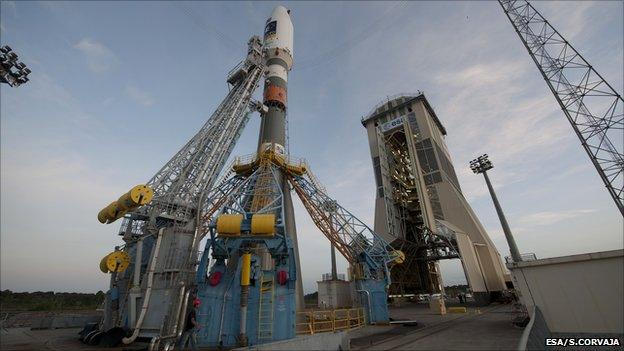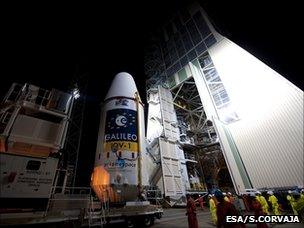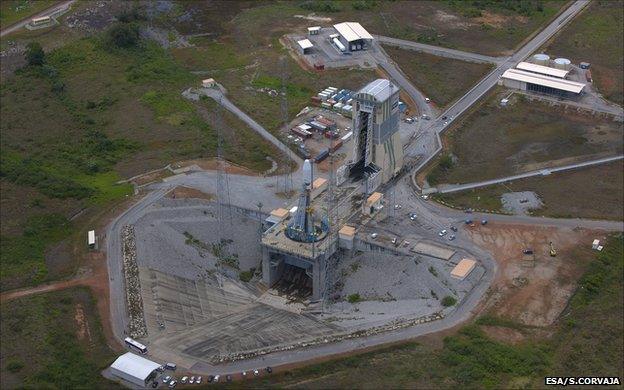A rocket abroad - Soyuz in French Guiana
- Published
- comments

It is one of the most important weeks in the history of European space activity.
On Thursday, two satellites will launch from French Guiana to begin the process of rolling out Galileo, external - Europe's multi-billion-euro version of the American Global Positioning System (GPS).
If that were not significant enough, the spacecraft will ride to orbit on the first Russian Soyuz rocket to operate from Western territory.
I'll talk more of Galileo later in the week, but I want to concentrate on Soyuz for this posting.
Formally initiated by European space ministers in 2003, external, the new Soyuz launch complex has been constructed at Europe's spaceport - the Guiana Space Centre (CSG - Centre Spatial Guyanais), external.
It is inside the Sinnamary commune about 15km up the coast from the Kourou commune where the pad was built for Europe's heavy-lift workhorse, the Ariane 5 rocket.
Arianespace's Jean-Yves Le Gall: Advantage for all sides
Engineers have cleared an area of jungle to build a 120ha, near-facsimile of the Soyuz facilities, external used through the decades at Baikonur, in Kazakhstan, and Plesetsk, in northern Russia.
Those familiar with TV pictures of Baikonur will instantly recognise the giant flame bowl that deflects the exhaust gases and noise away from the rocket as it begins its ascent. Having stood in the new bowl a couple of times myself, I can attest to its immense scale - 250,000 cubic metres of rock and earth had to be dug out of the ground to make it.
Present also is a 700m-long railway to take the rocket from its integration building, the MIK, to the pad, where, just as in Baikonur and Plesetsk, the four-stage vehicle is raised into the vertical position ready for its mission. Bright yellow and blue support towers hold the rocket in place.
"If it ain't broke, don't fix it," they say, and the purpose of all this deja vu is to ensure the new Sinnamary home of Soyuz stays as true as possible to a very successful launch heritage.

Like Baikonur, Sinnamary has a large flame bowl under the pad
A key difference is the mobile gantry, withdrawn prior to launch
Soyuz receives a big boost by launching closer to the equator
Rockets are brought to the pad along a 700m-long rail line
The segments of a Soyuz are assembled in the MIK building
Launch control is just 1km from the pad, in a secure bunker
Other buildings on the 120ha site include propellant storage areas
There are differences, of course - some a little less obvious to the casual eye.
The Soyuz-ST, the vehicle that will be used in French Guiana, has a bigger clam-shell fairing enclosing its satellites - 4.11m in diameter compared to 3m on a "classical" Soyuz.
It's also got a digital flight control system and a modified upper stage. But these "evolutions" have all been tested in launches from Baikonur already, and so cannot really be described as "new" for Thursday.
Another "under the skin" change concerns the method used to terminate a flight if it goes wrong.
Back in Kazakhstan or Russia, the detection of an anomaly results in an automatic engine shutdown. With no power, the rocket simply falls from the sky and is destroyed when it hits the ground.

Soyuz in French Guiana will be using a wider clam-shell fairing for the bigger payloads
"In French Guiana, this will be same - plus, we will have the capacity to telecommand to stop the engine," explained Jean-Marc Astorg, from the French space agency (Cnes), who has led the Soyuz in French Guiana project.
"So, there will be a Cnes officer who will be following the flight, and if the trajectory is not nominal - he will push a button. It's an additional safety measure."
Perhaps the most noticeable difference in operation is the 52m-tall mobile gantry, which will be used to install the satellites on top of the rocket.
In Baikonur and Plesetsk, the satellites are always attached to the Soyuz while the rocket is still in the horizontal. But the spacecraft preparation facilities at the CSG are set up to do it in the vertical, and so the new gantry has been developed to fit with European custom and practice.
"It also means that if we wanted to change a payload from a Soyuz to an Ariane 5, or from an Ariane 5 to a Soyuz - that would be easy. And we need the gantry for environmental reasons. There are heavy rains in French Guiana, mosquitoes even - so it is better to protect the people working there."
However, getting the gantry built in Russia, shipped to French Guiana, and then assembled and running smoothly on its bogeys, proved quite a struggle. This one item alone added over a year to the project timeline and significantly increased its final cost.
Basing Soyuz in French Guiana should give the rocket a new lease of life. By launching closer to the equator, the rocket receives a bigger boost from the Earth's rotation, meaning it can lift nearly double the mass of a normal Baikonur payload - a maximum of three tonnes, as opposed to 1.7 tonnes, into a geosynchronous orbit 36,000km above the Earth.
And the "European Soyuz" should be a fillip for Arianespace, external, the company set up to market and operate the Ariane rockets.
Across the board
With a new small vehicle called Vega, external also set to debut early next year, Arianespace will soon offer the full portfolio of launch services from CSG, external.
Ariane will put in orbit the really big telecommunications satellites, Soyuz will loft the medium-class spacecraft, and Vega will take care of the compact scientific payloads.
"The talks about Soyuz in French Guiana started in the late 90s when we began the co-operation with Soyuz at Baikonur with [our subsidiary] Starsem, and in parallel there was - I would say - an opinion shared in Russia and Europe that it could be interesting to build a Soyuz launch pad in French Guiana," Jean-Yves Le Gall, the chairman and CEO of Arianespace, told me.
"For the Russians, the advantage is obvious - to have more launches and so to produce more launch vehicles. And for the Europeans, it was clear that the Ariane 5 would become bigger and bigger, and so we needed a mid-class launch vehicle.
"Developing a mid-class launch vehicle in Europe would have cost between three and five billion euros, and building the Soyuz launch pad has been just - if I can say 'just' - around 400 million euros," he explained.
"The other benefit is that we are able to launch from French territory some satellites with classified components that cannot be sent to Russia or Kazakhstan - for instance, Galileo. For Galileo, we are obliged to launch from French territory."
At the moment, Soyuz is used at Baikonur to launch astronauts to the International Space Station. No-one is talking about human missions for CSG yet, but the space in the jungle is there to build the additional facilities if that option is ever taken up.
UPDATE (09/11/2011): I should add that before a Soyuz manned mission could ever fly from Sinnamary, considerable modifications would need to be made to its TMA capsule, which was designed to come back on land. A French Guiana launch would necessitate a contingency for an abort over the ocean, and getting the crew out of an unmodified capsule in water would be precarious to say the least.
